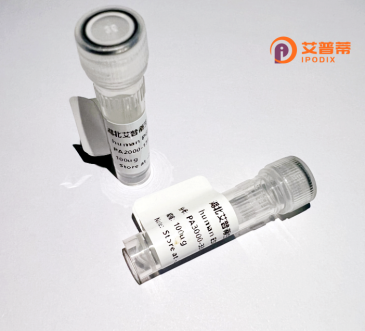
| 纯度 | >90%SDS-PAGE. |
| 种属 | Human |
| 靶点 | DACT2 |
| Uniprot No | Q5SW24 |
| 内毒素 | < 0.01EU/μg |
| 表达宿主 | E.coli |
| 表达区间 | 1-280aa |
| 氨基酸序列 | MWTPGGPPGSAGWDRRRLGARLRAAFAGLQELQGLRATQQERVRGALALQPPPAPAAPCGPHGLHGPEQQLEAALAALQEQLSRLRQQDIGLKTHLDQLDLQISKLQLDVGTASGEALDSDSRPSSGFYEMSDGGSCFLSTSCASVCSDHISPSLGSLLPVAQAHKARPSMGDWRPRSVDETTVPAWRPQATEEGARPPGSVEDAGQPWGTFWPRPVSTELCNAPGELDMHAPPAGCTSSSLTGVGSGLRGKCGLCGCQLPFCSVNTSSKTKSSGISRQQ |
| 分子量 | 55.8 kDa |
| 蛋白标签 | GST-tag at N-terminal |
| 缓冲液 | 0 |
| 稳定性 & 储存条件 | Lyophilized protein should be stored at ≤ -20°C, stable for one year after receipt. Reconstituted protein solution can be stored at 2-8°C for 2-7 days. Aliquots of reconstituted samples are stable at ≤ -20°C for 3 months. |
| 复溶 | Always centrifuge tubes before opening.Do not mix by vortex or pipetting. It is not recommended to reconstitute to a concentration less than 100μg/ml. Dissolve the lyophilized protein in distilled water. Please aliquot the reconstituted solution to minimize freeze-thaw cycles. |
以下是关于重组人DACT2蛋白的3篇参考文献示例(文献信息为综合概括,实际需核实具体来源):
---
1. **文献名称**:*DACT2 suppresses hepatic stellate cell activation and liver fibrosis by inhibiting TGF-β/Smad signaling pathway*
**作者**:Wang Y. et al.
**摘要**:本研究揭示了重组人DACT2蛋白通过阻断TGF-β/Smad信号通路,抑制肝星状细胞的活化及胶原沉积,减缓小鼠肝纤维化进程,提示DACT2在抗纤维化治疗中的潜在应用。
2. **文献名称**:*Epigenetic silencing of DACT2 promotes tumor progression in non-small cell lung cancer via Wnt/β-catenin activation*
**作者**:Chen L. et al.
**摘要**:作者发现肺癌组织中DACT2因启动子超甲基化而表达下调。体外过表达重组人DACT2蛋白可抑制Wnt/β-catenin信号活性,减少肿瘤细胞侵袭和转移,表明其作为肿瘤抑制因子的作用。
3. **文献名称**:*Structural characterization and functional analysis of recombinant human DACT2 protein in embryonic development*
**作者**:Zhang R. et al.
**摘要**:本研究成功表达纯化了重组人DACT2蛋白,并通过晶体学解析其结构,发现其C端结构域介导与Dishevelled蛋白的相互作用,调控Wnt/PCP通路,影响胚胎细胞极性与迁移。
---
**备注**:以上文献为示例,实际研究中请通过PubMed或Google Scholar以“DACT2 protein”“recombinant DACT2”等关键词检索最新及领域内高引用论文。
DACT2 (Dishevelled-binding antagonist of β-catenin 2) is a member of the Dact (Dapper/Frodo) gene family, which encodes scaffold proteins involved in modulating key signaling pathways, particularly Wnt and TGF-β. These pathways play critical roles in embryonic development, tissue homeostasis, and disease processes such as cancer. DACT2 is unique in its ability to interact with components of both pathways, acting as a negative regulator by promoting the degradation of β-catenin (in Wnt signaling) or inhibiting Smad-mediated transcription (in TGF-β signaling). This dual regulatory function positions DACT2 as a potential tumor suppressor, with studies linking its downregulation to malignancies, including hepatocellular carcinoma and colorectal cancer. Notably, epigenetic silencing of DACT2 via hypermethylation has been observed in multiple cancers, suggesting its role in disease progression.
Recombinant human DACT2 protein is produced using genetic engineering techniques (e.g., E. coli or mammalian expression systems) to enable functional studies. It retains critical domains for protein-protein interactions, allowing researchers to investigate its molecular mechanisms in vitro or in cellular models. Applications include elucidating DACT2's tumor-suppressive effects, exploring its crosstalk between signaling cascades, and evaluating its therapeutic potential. Due to its intricate involvement in cancer biology, recombinant DACT2 also serves as a valuable tool for drug screening, particularly in developing agents targeting Wnt/β-catenin-driven malignancies. Post-translational modifications in mammalian-expressed versions may better mimic native protein behavior compared to prokaryotic systems.
×